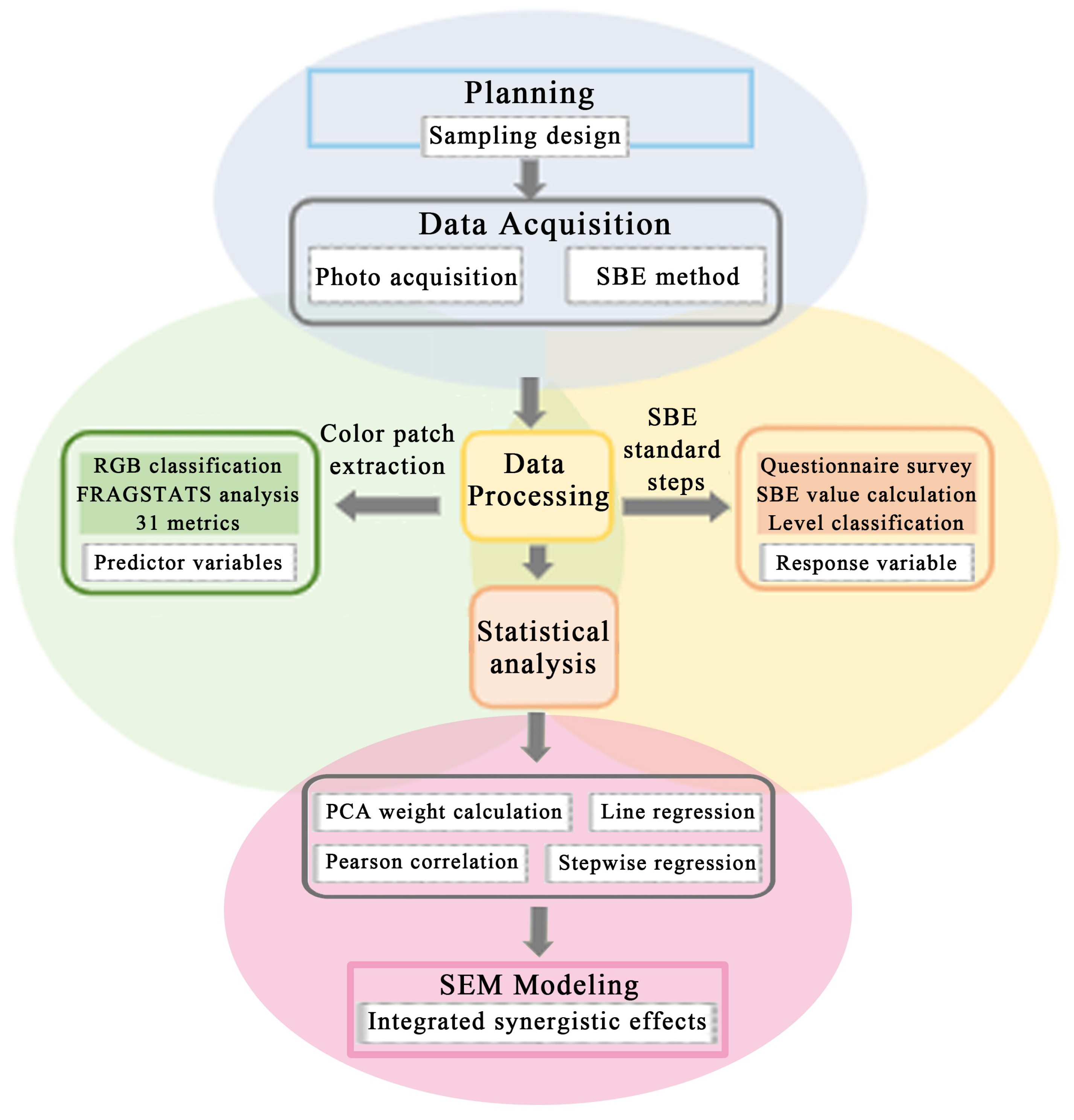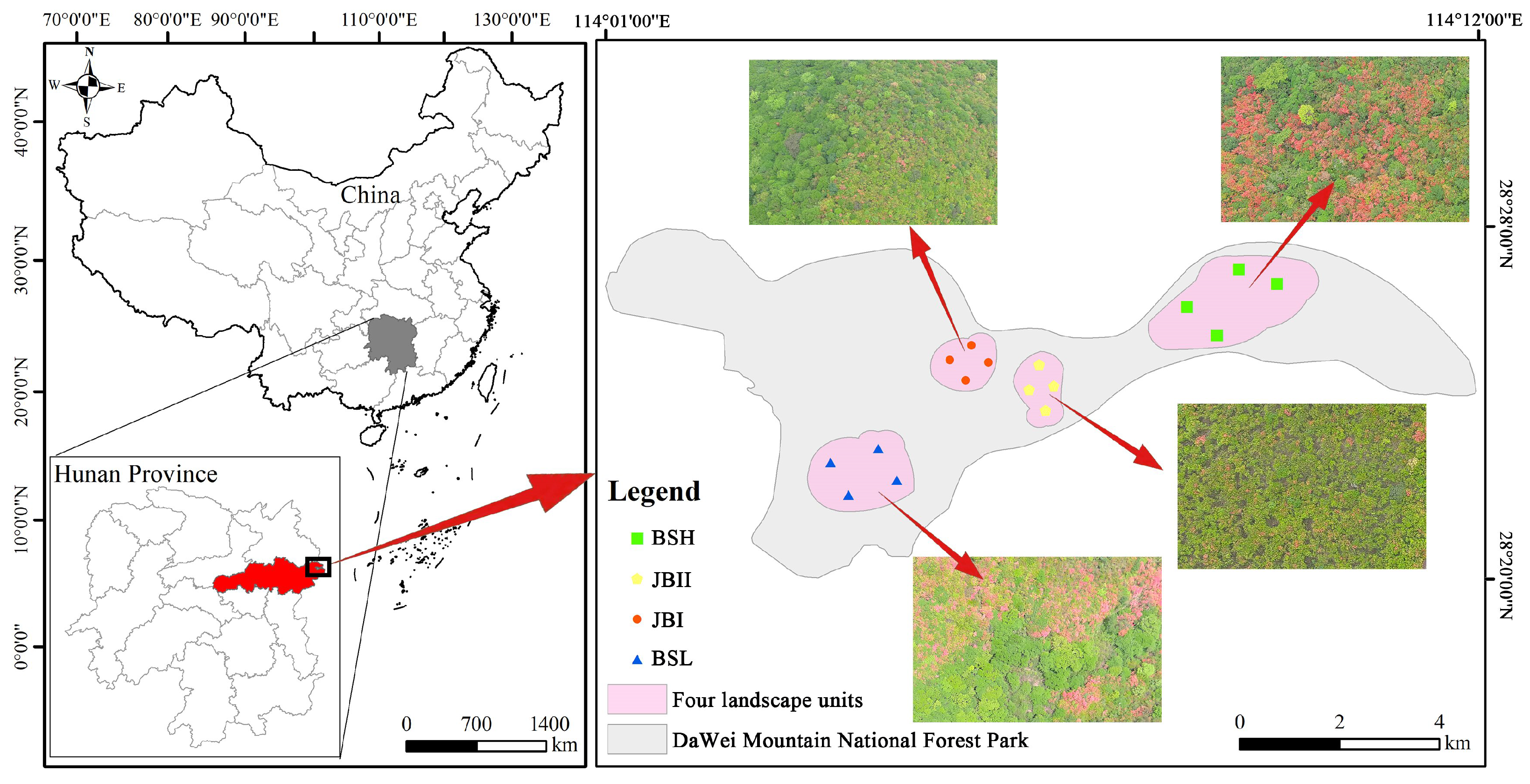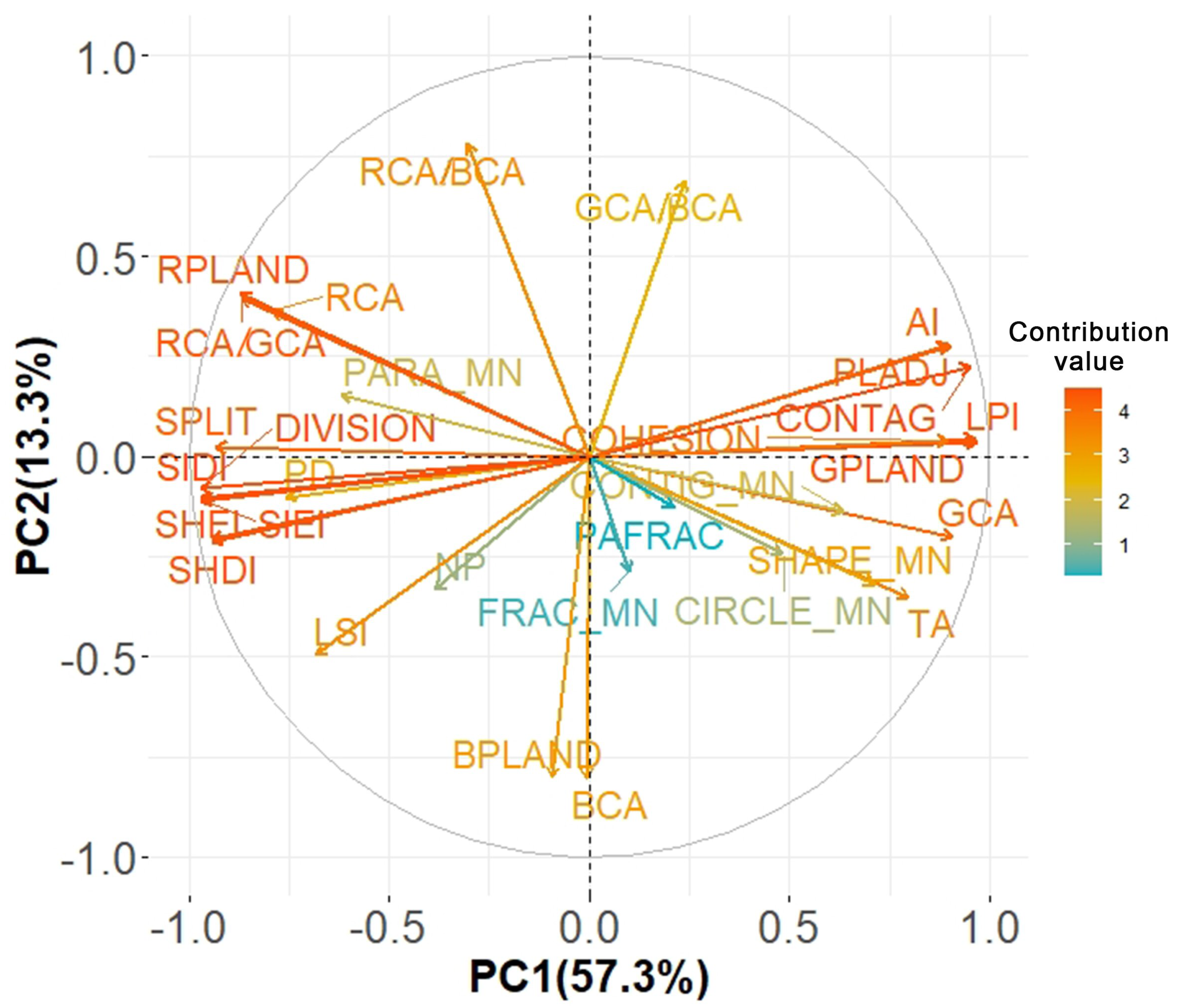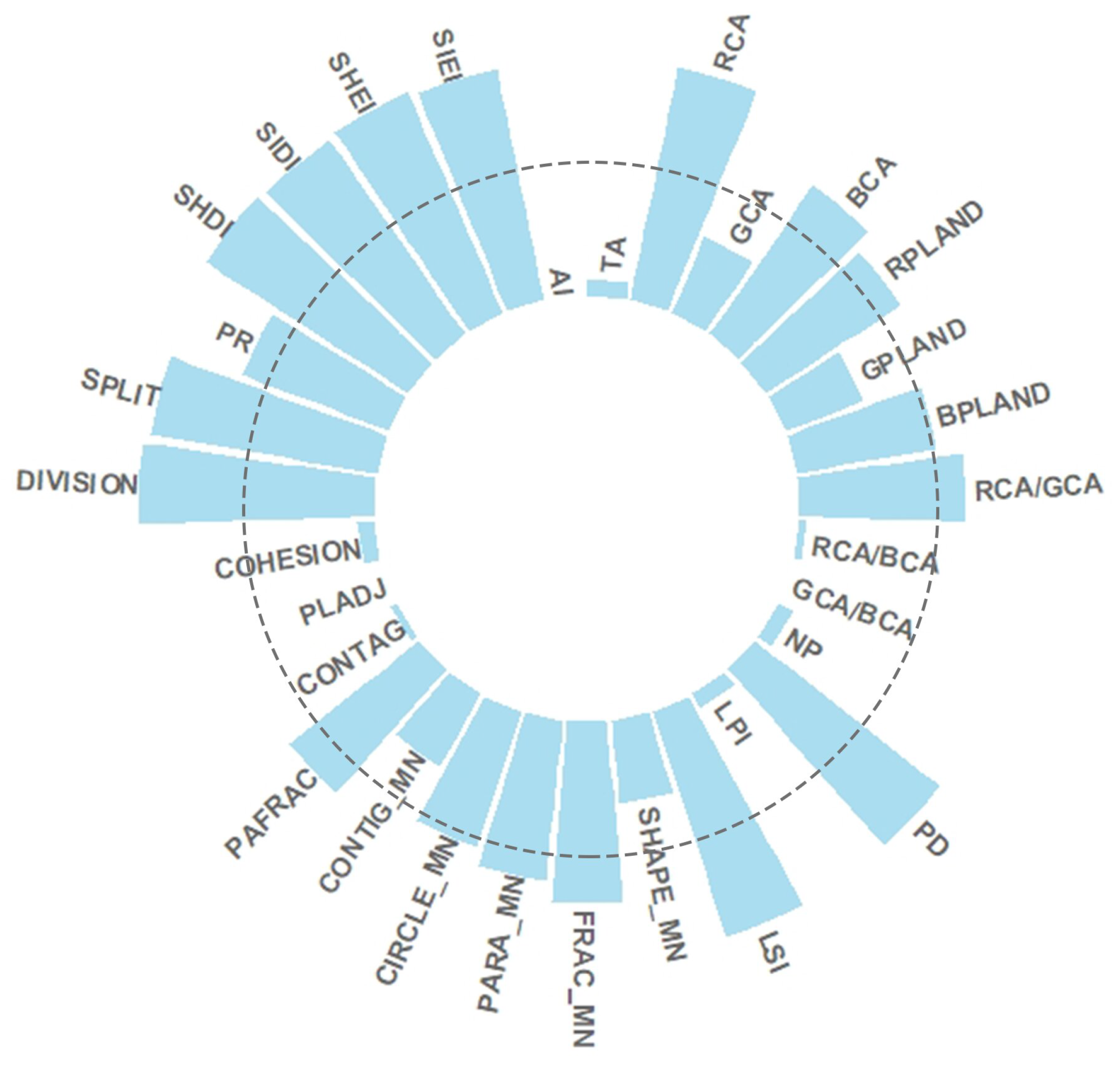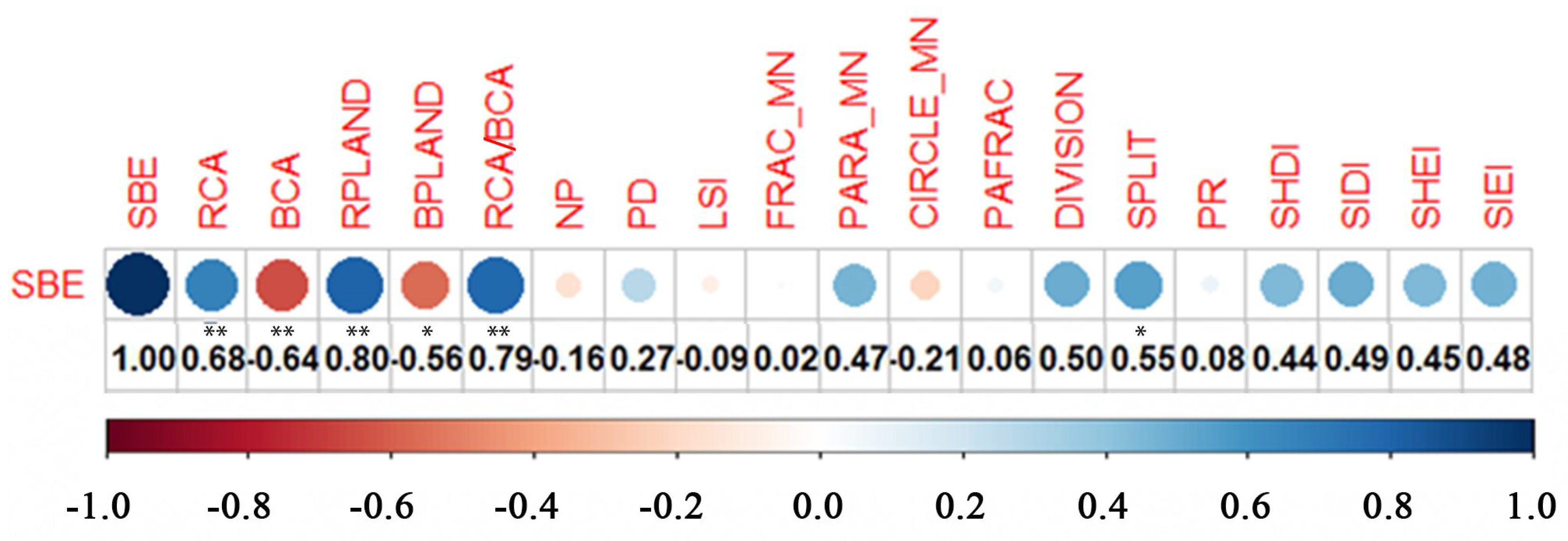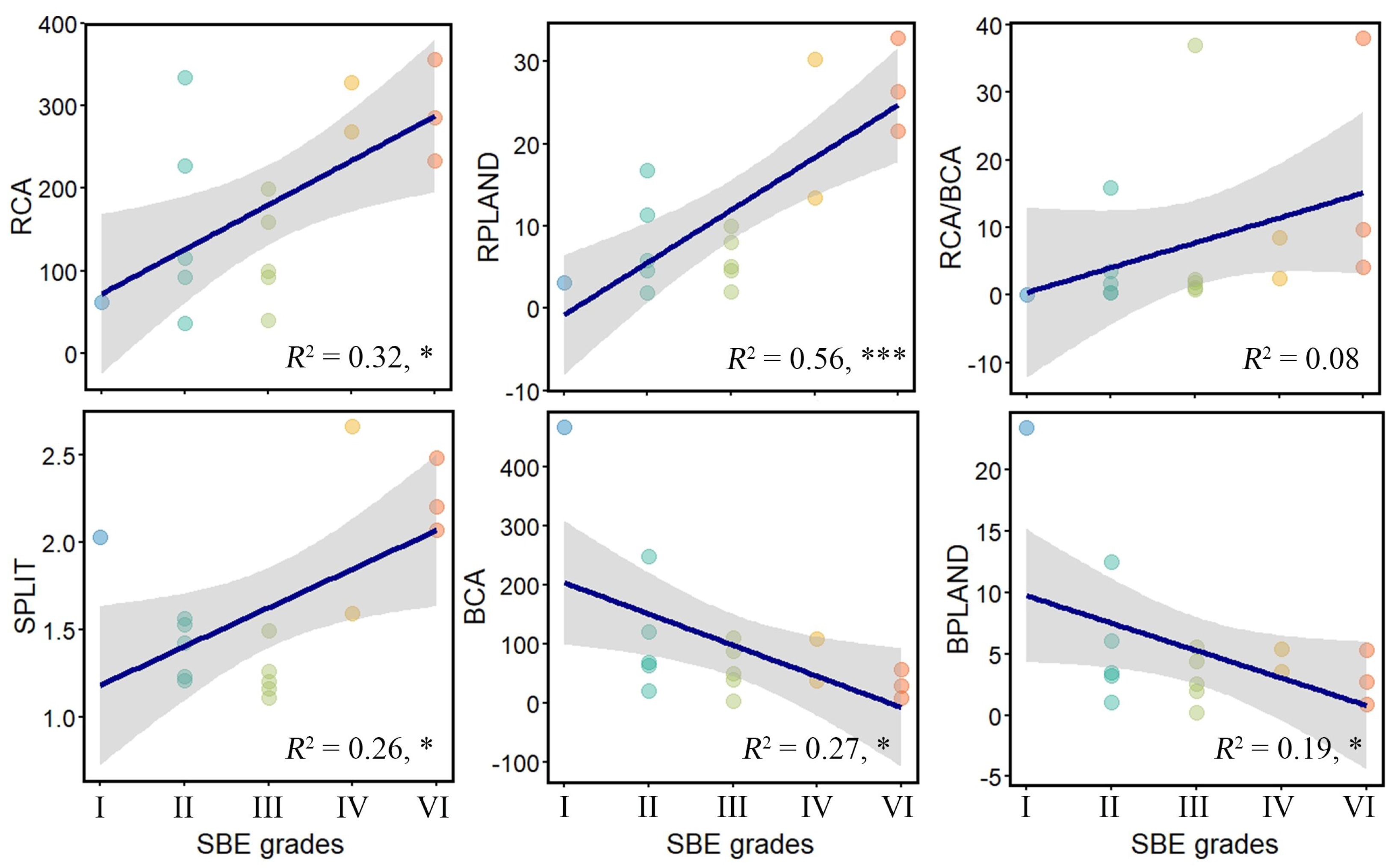1. Introduction
With rapid socioeconomic development and urbanisation, public demand for suburban recreation, ecotourism, and nature-based wellness is surging [
1]. This demand has increased interest in the concept of landscape recreational forests—forest ecosystems specifically managed to deliver high visual quality (defined as the psychological and aesthetic response elicited by human visual cognition of landscape characteristics, including spatial structure, chromatic contrast, and visual permeability) [
2,
3,
4]. Landscape recreational forests aim to satisfy multifaceted recreational needs (i.e., leisure and health) while satisfying aesthetic preferences [
5,
6,
7,
8]. Consequently, the sustainable development of these valuable ecosystems critically depends on the robust scientific assessment of their landscape quality.
To satisfy this requirement for objective assessment, evaluation methodologies have evolved significantly. Early forest landscape evaluation relied predominantly on qualitative expert appraisals (i.e., the descriptive factor method) [
2]. The 21st century witnessed a paradigm shift towards integrating quantitative rigour, culminating in the prominence of scenic beauty estimation (SBE) [
9,
10,
11,
12,
13,
14]. SBE quantifies the relative aesthetic value of landscapes by statistically aggregating human perceptual responses, objectively capturing interactions between natural/cultural aesthetics and human visual perception [
9,
15,
16]. Its strengths lie in its high repeatability, comparability, and, crucially, the ability to bridge landscape structural characteristics and universal aesthetic principles through empirical modelling [
17,
18], enabling the prediction of scenic beauty based on measurable elements. This empirical modelling capability is particularly vital for understanding how specific, quantifiable landscape features drive aesthetic responses.
A critical dimension influencing aesthetic response in expansive forest landscapes is viewing distance. Visual experience varies fundamentally with distance: far-distance vision offers a macroscopic perspective, emphasising large-scale patterns like canopy lines and colour patches [
19,
20,
21]. Within this context, far-distance visual quality, a specialised facet of overall visual quality, is governed by macro-scale landscape attributes, particularly chromatic salience and geomorphological integrity [
22,
23]. Here, colour emerges as the dominant sensory input, commanding approximately 80% of viewer attention during far-distance landscape appreciation [
24]. Its profound influence on public landscape preferences [
25] and far-distance visual quality [
26,
27] has earned it the designation as the “first element of vision” [
24]. Consequently, optimising colour’s visual–aesthetic properties, especially the configuration of large-scale colour patches, is paramount for enhancing overall landscape quality in recreational forests viewed from afar [
28,
29,
30].
Planch. provides a compelling illustration of the critical role of colour patches in far-distance forest aesthetics. Celebrated for its high ornamental value and vibrant floral displays [
31,
32,
33], it is extensively utilised in landscape recreational forest design. As a species of significant ecological and cultural value in China, it has provincial flower status in Hunan and city flower status in Changsha [
34,
35]. Its extensive distribution in Hunan’s high-altitude regions (>1000 m), including key sites like DaWei Mountain National Forest Park, underpins vital alpine ecological functions and forest tourism economies [
34,
35]. During its flowering period,
R. simsii generates distinctive colour patches—spatially discrete areas defined by hue—which are pivotal determinants of far-distance visual quality within landscape recreational forests, affected by coverage and geometric configuration [
25,
36].
Despite the acknowledged significance of these
R. simsii colour patches [
25,
36], a critical research gap persists at the intersection of SBE modelling, far-distance visual quality, and colour patch configuration. While empirical evidence suggests that far-distance visual quality is highly sensitive to the spatial pattern of these patches (i.e., their size, distribution, proportional coverage, shape, and complexity) [
25,
36], rigorous quantification of the specific relationships between measurable colour patch spatial pattern metrics and objectively assessed far-distance scenic beauty remains nascent. Current research is largely exploratory, lacking robust mechanistic models that elucidate how these patch characteristics collectively drive aesthetic responses specifically in the far-distance visual domain. This gap impedes the development of evidence-based, spatially explicit management strategies for optimising the visual quality and recreational value of
R. simsii landscapes, which are ecologically and economically significant [
34,
35].
To bridge this critical knowledge gap and provide a scientific foundation for optimising the management of these valuable landscapes, this study aimed to (1) quantify the specific relationships between key measurable spatial pattern metrics of
R. simsii colour patches and objectively evaluated far-distance scenic beauty using the SBE method; (2) elucidate the collective influence and relative importance of these spatial pattern metrics on far-distance SBE scores, thereby revealing the underlying mechanistic drivers of aesthetic perception in this specific context; and (3) identify the dominant spatial pattern metrics that most significantly influence far-distance visual quality in
R. simsii recreational forests. We pursued these objectives by focusing on the
R. simsii landscape recreational forests within DaWei Mountain National Forest Park, Hunan Province. We selected 16 aerial photographs capturing the full spectrum of spatial heterogeneity in colour patch patterns (i.e., variations in patch size, distribution density, and chromatic contrast) across the
R. simsii forests. These variations were hypothesised to drive divergent aesthetic perceptions based on established principles of landscape preference [
25,
36]. Subsequently, 31 colour patch indicators (i.e., patch area, percentage of patch area, and landscape shape index) were extracted from these images to quantify landscape structural characteristics. Our primary objectives were to (1) model the dynamics of aesthetic quality (SBE) in response to colour patch patterns and (2) identify the key colour patch indicators stimulating far-distance visual quality in
R. simsii landscapes. We tested the following hypotheses: (1) the aesthetic quality of
R. simsii landscape recreational forests is primarily enhanced by the structural attributes of its colour patches (hue and intensity) and their spatial heterogeneity, and (2) far-distance visual quality is collectively influenced by the area percentage, shape complexity, and spatial configuration of the dominant colour patches.
2. Materials and Methods
2.1. Study Area
The study area was located in DaWei Mountain National Forest Park, situated in Liuyang City of Hunan Province (28°20
′–28°28
′ N, 114°01
′–114°12
′ E). The topography features erosion of granite landforms at an elevation of 76–2365 m above sea level. The area is characterised by a humid subtropical monsoon climate with an annual average precipitation of 1800–2000 mm and an annual mean air temperature between 11 and 16 ℃ [
37,
38]. Seasonally, average temperatures range from −4 to 2.5 ℃ in winter (dry season) and from 20 to 28 ℃ in summer (wet season). The soils are mainly developed from granite and mudstone. The soil type exhibits distinct vertical zonation: mountain yellow-brown earth predominates above 1200 m; mountain yellow earth predominates between 800 and 1200 m; and areas below 800 m are characterised by red earth [
39].
Regarding land use within the park, the core areas of DaWei Mountain National Forest Park, particularly the mid-to-high elevation zones (above approximately 1200 m) where most of the
R. simsii communities occur, are strictly protected and managed for conservation and ecotourism [
40]. These areas are dominated by natural forest ecosystems. There are no agricultural activities (crop cultivation) or significant building construction within these core forest zones or specifically within the
R. simsii stands targeted by our study [
41]. Minor infrastructure associated with tourism (e.g., viewing platforms, trails, small rest stations) exists but was deliberately excluded from our aerial photography sampling locations to focus solely on the natural landscape patterns of the
R. simsii colour patches.
To optimise reader accessibility and scientific reproducibility, our investigation meticulously followed the procedural framework detailed in
Figure 1.
2.2. Sampling Design and Photo Acquisition
Four landscape units (Baishihu Flower Sea, Baishilong Flower Sea, and Jiebei Flower Seas I and II) were selected using typical sampling. Within each unit, four 50 m × 50 m replicate plots were systematically positioned based on (1) representative
R. simsii coverage; (2) homogeneous topography, and (3) minimum 500 m separation between plots to ensure independence. The 16 plots’ locations and appearance characteristics are shown in
Figure 2.
Building upon the established role of maps and aerial imagery as boundary objects in environmental decision-making and participatory planning [
42], this study leverages unoccupied aerial vehicles (UAVs/drones) to bridge high-resolution remote sensing and human landscape perception. In May 2021, aerial photographs were taken following standardised forest landscape photography principles [
5,
43,
44]: (1) Non-stand elements were avoided (i.e., roads, equipment); (2) Photographs were taken under sufficient light; (3) Parameters were consistent (DJI Phantom 4 Pro drone at 100 m altitude; nadir orientation; 2.9 cm/pixel resolution).
Sixteen representative photographs (one per plot) were systematically selected from sixty-four candidates through a multi-stage screening protocol that integrated colourimetric analysis and perceptual validation (see
Supplementary File S1). The selection adhered to the following criteria:
(1) Exclusion of artificial elements: photographs containing non-vegetation landscape features (i.e., infrastructure, human artifacts) were systematically excluded;
(2) Optimal lighting control: images captured under backlit or side-lit conditions were discarded to ensure consistent illumination;
(3) Illumination consistency: photographs with comparable solar geometry ( azimuth) and cloud cover (Okta ) were prioritised;
(4) Information richness maximisation: images with low informational value (entropy bits) were excluded in favour of those optimally representing landscape typologies.
2.3. Colour Patch Extraction
Landscape photographs of distant forest views were processed using Adobe Photoshop to delineate colour patches. Colour calibration was conducted using the X-Rite ColorChecker Passport (mean ). Ambiguous edges, such as flower–leaf transitions, were manually refined. Visual interpretation served as the primary classification criterion, segregating landscape elements into three chromatic categories based on the following spectral characteristics:
(1) Red patches: Corresponding to flowers of R. simsii (R: 220–255, G: 0–60, B: 0–50);
(2) Green patches: Representing foliage of R. simsii and co-occurring tree species (R: 0–100, G: 90–200, B: 0–120);
(3) Black patches: Denoting shaded tree bases and bare ground (R + G + B < 80, Saturation < 0.1).
Patch classifications were subsequently reclassified in ArcGIS 10.2 (ESRI, Redlands, CA, USA), with automated batch processing via Python ArcPy Module of ArcGIS 10.2. Raster conversion (5 cm resolution) of digitised images enabled quantitative landscape pattern analysis using FRAGSTATS 4.2 [
45], extracting key colour patch indices (i.e., patch density, edge complexity).
The landscape indexes were divided into three levels: (1) patch level (processed for individual patches); (2) class level (processed for different types of patches); and (3) landscape level (processed for different land cover classes of patches).
Based on the characteristics of the forest landscape, we selected 31 indicators for analysis: total landscape area (TA), red patch area (RCA), green patch area (GCA), black patch area (BCA), percentage of red patch area (RPLAND), percentage of green patch area (GPLAND), percentage of black patch area (BPLAND), number of patches (NP), patch density (PD), red patch area/green patch area (RCA/GCA), red patch area/black patch area (RCA/BCA), green patch area/black patch area (GCA/BCA), largest patch index (LPI), landscape shape index (LSI), mean patch fractal dimension (FRAC-MN), mean perimeter area ratio (PARA-MN), mean shape index (SHAPE-MN), mean contiguity index (CONTIG-MN), mean related circumscribing circle (CIRCLE-MN), contagion index (CONTAG), path cohesion index (COHESION), landscape division index (DIVISION), perimeter area fractal dimension (PAFRAC), percentage of like adjacencies (PLADJ), Simpson’s evenness index (SIEI), Simpson’s diversity Index (SIDI), Shannon’s diversity Index (SHDI), separation index (SPLIT), Shannon’s evenness index (SHEI), patch richness (PR), and landscape aggregation index (AI). A full list and descriptions are provided in
Table A1.
2.4. Scenic Beauty Estimation Method
The main work was performed in accordance with standard SBE steps, including a detailed survey of the sample plots, acquisition of forest landscape photographs, selection of landscape evaluation photographs, landscape evaluation, decomposition of landscape elements, data standardisation processing, and establishment of mathematical models. The landscape evaluation method mainly adopted the online questionnaire survey method (guiding participants to operate from a computer or mobile phone by posting a link) to obtain universal aesthetic standards of the evaluator [
9,
15]. Several studies have shown that there is no statistical difference in the aesthetic senses of different evaluation subjects [
46,
47,
48]. Professional and non-professional group assessors are consistent in making aesthetic evaluations of plant communities, but the professional group exhibits a greater sensitivity to the aesthetics of the plant community [
49]. To ensure the objectivity and accuracy of the evaluations, we selected a total of 1549 participants, mainly graduate students and some social workers majoring in relevant subjects in school. This study involving human participants was conducted in accordance with institutional guidelines and the National Ethical Review Regulations for Non-Biomedical Research (Article 17, 2021). Formal ethics committee approval was waived as this study (1) exclusively employed anonymous questionnaire surveys; (2) involved no clinical interventions or sensitive data collection; (3) posed minimal risk (Category A per CIOMS Guidelines). All participants provided written informed consent in compliance with the Declaration of Helsinki (2013) [
50]. The survey protocols ensured (1) confidentiality, as data were anonymised through participant ID coding; (2) voluntary participation, with the option to withdraw without penalty; (3) privacy protection, as secure storage was used, per GDPR Article 32.
The specific process was as follows [
14,
51,
52]:
(1) Participants electronically signed informed consent documentation confirming their voluntary participation before the study commenced.
(2) Survey objectives and scoring criteria were introduced, and all 16 photographs were previewed to establish perceptual baselines.
(3) Photographs were displayed individually in fixed sequence with a fixed display duration (60 s per image). The beauty of the landscape was scored using a 7-point Likert scale to represent the degree of scenic appeal: very like (3), like (2), slightly like (1), neutral (0), slightly dislike (−1), dislike (−2), and very dislike (−3).
(4) All participants were counted after the evaluation, and disqualified questionnaires (duplicate submissions and incomplete responses) were removed. Then, the beauty value of each landscape photo was counted according to the calculation method.
The complete survey instrument is provided as
Supplementary File S1, featuring the informed consent form, survey questionnaire, and statistical analysis report.
2.5. Data Statistical Analysis
2.5.1. Predictor Variables: Colour Patch Metrics
The 31 colour patch metrics served as predictor variables.
Min–max normalisation method. We adopted min–max normalisation to standardise the raw data. This is a classical data processing and pre-processing technique which can convert the data to the ratio between the original values [
53] calculated by Equation (
1).
where
x represents the original data;
and
, respectively, represent the maximum and minimum values in the original data group of the same indicator; and
represents the standardised data.
Weight calculation of colour patch indicators. After data standardisation, principal component analysis was used to determine the weights of colour patch indicators and was calculated by Equations (2) and (3).
where
m represents the extraction number of colour patch indicators;
represents the load value of the i-th indicator of the j-th principal component;
represents the eigenvalue of the j-th principal component;
represents the variance (%) of the j-th principal component;
M represents the coefficient in the comprehensive score model of n principal components;
represents the standardisation coefficient in the principal component composite score model treated by min–max normalisation (Equation (
1)); and
w represents the weight of the i-th indicator in the colour patch extraction index. Due to the possibility of negative load values for each indicator in principal component analysis,
M may have negative values. According to the 3
criterion, the coordinate translation method was used to shift the
M values of all indicators to the right by 1 to eliminate the influence of negative numbers, facilitating weight calculation and the next step in the analysis.
2.5.2. Response Variable: Scenic Beauty Estimation
. The SBE method standardising equation was used to standardise the rating scores of each photo from 1538 people in the evaluation questionnaire, calculate the average standardised score (
Z value) for each sample photo, and further calculate the SBE scores of the sample land. The calculation was carried out using Equations (4) and (5).
where
represents the rating value of the j-th survey object on the i-th landscape;
represents the average of all scoring values for the j-th survey object;
represents the standard deviation of all scoring values for the j-th survey object;
represents the standardised score obtained by the j-th survey object for the i-th landscape;
represents the number of personnel participating in the i-th landscape evaluation; and
is the final SBE score for the i-th landscape.
. Scenic beauty was divided into five levels using the equal difference method [
54]: the first grade is very good (VI), the second is good (IV), the third is average (III), the fourth is poor (II), and the fifth is very poor (I). The specific calculation equations are shown in
Table 1.
. For data standardisation, to determine the average value and other routine calculations, we used the Microsoft Excel package. All statistical analyses were conducted using the R statistical software 4.4.3 package [
55]. Principal component analysis (extraction of SBE influence factor (colour patch indicators) and weight calculation) was implemented using the
package [
56] and visualised using the
[
57] and
packages [
58] of the R software. A Pearson correlation plot (correlation between SBE values and indicators of colour patches) was drawn using the
package [
59] in the R statistical software. The comprehensive weight value of colour patch traits of the landscapes was plotted using the
[
60],
[
61],
[
58], and
[
62] packages in R. Based on the results of the principal component and Pearson correlation analyses, we used linear function analysis to further examine the trend in key colour patch element indicators changing with the beauty grade. The figure of linear function analysiswas produced via the
[
58],
[
60], and
[
63] packages in R. Following the principal component analysis, we conducted stepwise regression analysis to determine the leading impact factors for the SBE values. This analysis was performed using the step function of R statistical software. Structural equation modelling (SEM) was performed using the
package [
64] in R to further examine the synergistic effects of the area percentage, shape, and space collocation of colour patches on the SBE. The figure of SEM analysiswas plotted by the
[
58], and
[
65] packages of R.
